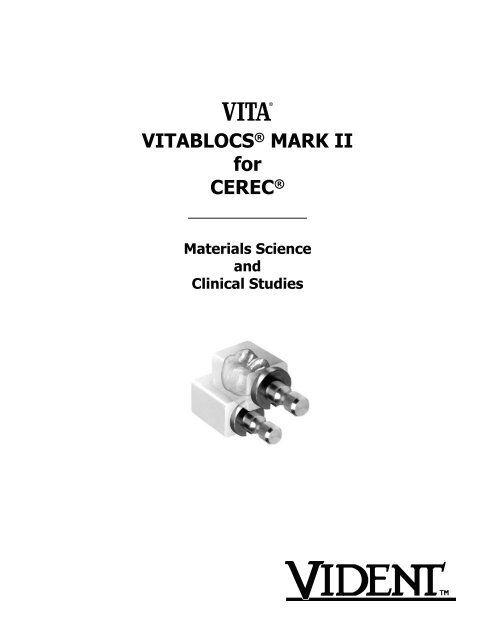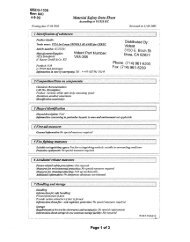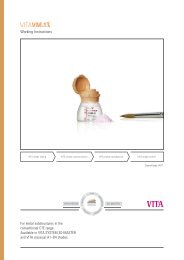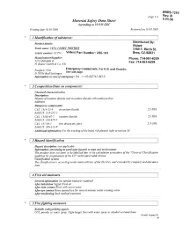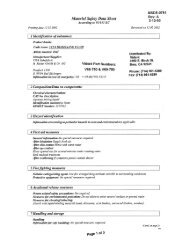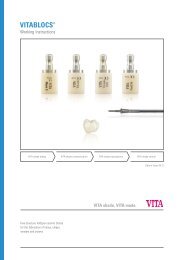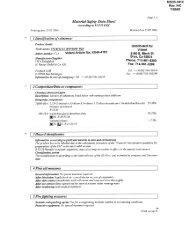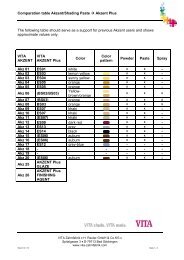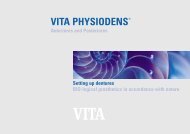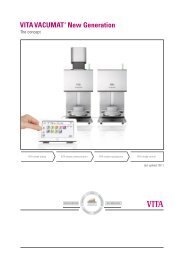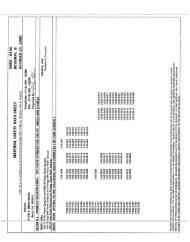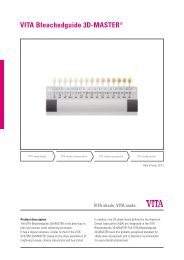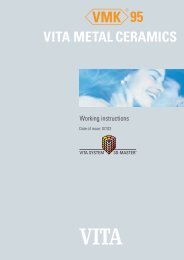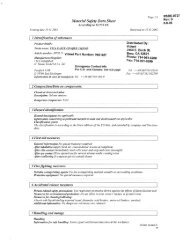VITABLOCS® MARK II for CEREC® - Vident, a VITA
VITABLOCS® MARK II for CEREC® - Vident, a VITA
VITABLOCS® MARK II for CEREC® - Vident, a VITA
Create successful ePaper yourself
Turn your PDF publications into a flip-book with our unique Google optimized e-Paper software.
<strong>VITA</strong>BLOCS ® <strong>MARK</strong> <strong>II</strong><br />
<strong>for</strong><br />
CEREC ®<br />
Materials Science<br />
and<br />
Clinical Studies
Background<br />
Materials Science<br />
The CEREC method is a system which has proved its clinical suitability <strong>for</strong><br />
the production of ceramic restorations in millions of cases. The CEREC<br />
system of Sirona Dental Systems GmbH (previously Siemens Dental) has<br />
been used <strong>for</strong> clinical applications since 1986. A second generation of<br />
fine-particle feldspar ceramic blocks, called CEREC <strong>VITA</strong>BLOCS Mark <strong>II</strong>,<br />
have been available since 1991; they are considered to be one of the<br />
most abrasion-resistant dental ceramics. The clinical survival rate after ten<br />
years <strong>for</strong> bonded restorations is approximately 95%. More than 6 million<br />
restorations have been prepared from <strong>VITA</strong>BLOCS <strong>for</strong> CEREC.<br />
The abrasion properties are highly similar to those of natural enamel. This<br />
is attributable to the industrial sintering process as well as to the small<br />
particle size (an average of 4µm) of this ceramic system. The feldspar<br />
particles are uni<strong>for</strong>mly embedded in the glass matrix; a detrimental “sanding<br />
(abrading) effect” on the antagonist is avoided. Standardized, controlled<br />
and industrial manufacturing using the industrial sintering process under<br />
vacuum at 1170ºC, which can be reproduced at any time, ensures a more<br />
homogenous microstructure with consistent material quality compared to<br />
laboratory sintered and lab-processed ceramic restorations. The results<br />
are a high flexural strength of 150 MPa prior to processing in the CEREC<br />
unit and a highly uni<strong>for</strong>m and retentive etching pattern due to selective<br />
etching of the feldspar matrix with hydrofluoric acid. Accordingly, safe and<br />
extremely durable adhesive bonding to the tooth substance is provided.<br />
The relatively high translucency of the Mark <strong>II</strong> ceramic blocks guarantees<br />
excellent integration of the shade into the residual tooth substance in<br />
most clinical situations without the need to individualize the shade. The<br />
<strong>VITA</strong>BLOCS ESTHETIC LINE is an even more translucent version of the<br />
Mark <strong>II</strong> ceramic with increased glass phase content, which makes it<br />
particularly suitable <strong>for</strong> anterior restorations.<br />
The requirements <strong>for</strong> proper machinability are perfectly fulfilled by the<br />
Mark <strong>II</strong> ceramic – during the mechanical grinding process as well as during<br />
dental reworking (corrections) where adjustments or corrections of the<br />
shape can be easily and accurately per<strong>for</strong>med intraorally using diamond<br />
grinding tools.<br />
800-828-3839 800-263-4778 in Canada www.vident.com
Composition and Mechanical Properties<br />
Property Unit of measure Value<br />
Mixture of feldspathic crystalline<br />
particles embedded in a glassy matrix<br />
Vol % ≈30<br />
Density g/cm 3 2.44 ± 0.01<br />
Refractive Index – 1.501 ± 0.001<br />
Expansion Coefficient 500ºC 10 -6 K -1 9.4 ± 0.1<br />
Trans<strong>for</strong>mation Area ºC 780 – 790<br />
Knoop Hardness HK 0.2/30 – 521 ± 8<br />
Vickers Hardness HV 0.1/15 – 640 ± 20<br />
Flexural Strength (H. Schwickerath,<br />
The Strength Characteristics of CEREC,<br />
Quintessenz 43, 669-677, 1992)<br />
Flexural Strength (1.2 x 4 x 15mm<br />
surface prepared by the CEREC 2<br />
machine 0.5mm/min.)<br />
MPa 154 ± 15<br />
MPa 113 ± 10<br />
Toughness (SENB method) MPa√m 1.7 ± 0.1<br />
Toughness (Vickers indentation) MPa√m 2.2 ± 0.1<br />
Young’s Modulus GPa 63.0 ± 0.5<br />
The above values should not be considered in isolation and are only of limited validity to clinical behavior. The given physical and technical<br />
values are typical values and apply to testing samples manufactured on our premises and in-house measuring equipment. If samples<br />
manufactured elsewhere and/or other measuring instruments are used, differing results are to be expected.<br />
800-828-3839 800-263-4778 in Canada www.vident.com
Reliability<br />
This study analyzed clinical trial data of over 1000 inlays and onlays fabricated using Vita Mark I and<br />
Mark <strong>II</strong> blocks which were examined 9 – 12 years after placement. A statistical analysis of the data<br />
demonstrates that at 5 years over 95% of the restorations are still clinically successful and at 10<br />
years at least 90% should still be functioning successfully. The success rate is even higher if only<br />
those restorations which were bonded are considered.<br />
Reiss, B., Walther, W. “Clinical long-term results and 10-year Kaplan-Meier analysis of CEREC<br />
Restorations” Int. Journal of Computerized Dentistry 2000 Sep; 3:8<br />
800-828-3839 800-263-4778 in Canada www.vident.com
Failure Load<br />
(Newtons)<br />
2500<br />
2000<br />
1500<br />
1000<br />
500<br />
0<br />
Natural<br />
Molars<br />
Tooth Rein<strong>for</strong>cement<br />
CEREC<br />
Ceramic Inlay<br />
IPS<br />
Empress<br />
Arabesk<br />
RBC *<br />
Teeth restored with bonded CEREC inlays were as resistant to fracture as natural sound (not<br />
restored) teeth. Teeth restored with Empress 1 inlays or composite resin were significantly weaker<br />
than natural teeth or those restored with CEREC inlays. Thus clinical survivability of teeth restored<br />
with the CEREC inlays may be enhanced as compared to those restored with Empress or composite<br />
resin.<br />
Bremer BD, Geurtsen W.J “Molar fracture resistance after adhesive restoration with ceramic<br />
inlays or resin-based composites” Dent 2001 Aug;14(4):216-20<br />
800-828-3839 800-263-4778 in Canada www.vident.com<br />
*<br />
Charisma F<br />
* Not a registered trademark of <strong>Vident</strong> or <strong>VITA</strong> Zahnfabrik<br />
*
Failure Load<br />
(Newtons)<br />
2500<br />
2000<br />
1500<br />
1000<br />
500<br />
0<br />
Fatigue Testing<br />
Procad * MK<strong>II</strong> Mz100 *<br />
* Not a registered trademark of <strong>Vident</strong> or <strong>VITA</strong> Zahnfabrik<br />
Crowns fabricated from Procad, Vita Mark <strong>II</strong> and Paradigm MZ 100 were tested be<strong>for</strong>e and after<br />
fatigue to simulate clinical conditions. All materials were less resistant to failure after fatigue testing<br />
but all failed at loads higher than the generally accepted maximum biting load.<br />
Tyan, B; Pober, R; Giordano, “Fatigue of CAD/CAM milled crowns” R. J. Dent. Res.<br />
2002 Special Issue MAR, VOL 81 Abstract #3963<br />
800-828-3839 800-263-4778 in Canada www.vident.com
Volume (mm 3 )<br />
Ratio Material Loss/<br />
Enamel Loss<br />
Roughness<br />
(Ra microns)<br />
Mean Volume Loss<br />
Enamel Wear Ratio<br />
Surface Roughness<br />
Wear Testing<br />
* *<br />
* *<br />
* *<br />
MK<strong>II</strong> Procad MZ100<br />
* Not a registered trademark of <strong>Vident</strong> or <strong>VITA</strong> Zahnfabrik<br />
800-828-3839 800-263-4778 in Canada www.vident.com<br />
Wear testing of polished materials<br />
against natural human tooth structure<br />
was per<strong>for</strong>med. The volume loss of the<br />
material and the natural tooth enamel was<br />
measured. The enamel loss of Vita Mark<br />
<strong>II</strong>, Procad and Mz100 were all statistically<br />
equivalent. The loss of material itself was<br />
higher with Mz100.<br />
If the enamel versus enamel test is<br />
normalized to a value of one, then we may<br />
rank the test materials relative to enamel<br />
versus enamel wear loss. Values close<br />
to one indicate wear behavior similar to<br />
enamel versus enamel. Values higher than<br />
one indicate loss of the material itself.<br />
The data indicates that Mark <strong>II</strong> is a wear-<br />
kind material, which does not deteriorate<br />
during tooth contact.<br />
The surface roughness of materials was<br />
measured be<strong>for</strong>e and after the wear<br />
test. There was no change in surface<br />
roughness of the Mark <strong>II</strong>. Procad became<br />
about 30% rougher and Mz100, although<br />
initially the smoothest became 700%<br />
rougher. As surfaces become rougher<br />
they may become dull and also may tend<br />
to accumulate more plaque than smooth<br />
surfaces.<br />
Abozenada, B, Pober, R, Giordano, R. “In-vitro wear of restorative dental materials”<br />
J. Dent. Res., Special Issue, VOL 81, MAR 2002, Abstract #1693
Abrasion and Chipping<br />
A complex chewing simulator was used to test the wear kindness of Vita Mark <strong>II</strong> blocks. This<br />
simulator replicates chewing motion, chewing loads, and fluid and thermal changes. The data<br />
reveals that after 5 years of simulated chewing the wear pattern of Mark <strong>II</strong> against enamel is similar<br />
to that of enamel against enamel. This further demonstrates the wear kindness of Vita Mark <strong>II</strong><br />
blocks.<br />
Krejci, I., Wear of ceramic and other restorative materials. International Symposium<br />
on Computer Restorations. Quintessence, 245-251, 1991.<br />
**Krejci, I. (German translation) Wear of enamel and amalgam and their enamel antagonists<br />
in a computer-simulated chewing simulation. Schweiz Monatsschr Zahnmed<br />
100: 1285, 1990<br />
Material Chipping Rank<br />
In-Ceram Alumina 1<br />
Mz100* 1<br />
MK<strong>II</strong> 2<br />
Procad* 3<br />
Standard pyramidal shapes were milled using Mark <strong>II</strong>, Procad, Mz100 and In-Ceram Alumina blocks.<br />
Edge chipping was categorized into three levels and ranked (< 75 microns, 75 - 200 microns, > 200<br />
microns). Mz100 and Vita In-Ceram Alumina demonstrated the lowest degree of chipping, followed<br />
by Mark <strong>II</strong>. Procad demonstrated the greatest degree of chipping primarily due to the higher<br />
number of large chips produced during milling.<br />
* Not a registered trademark of <strong>Vident</strong> or <strong>VITA</strong> Zahnfabrik<br />
Lee, Dal Ho, “Accuracy of Milled Porcelain, Ceramic and Composite Resin Materials,”<br />
Masters Thesis Boston University, Goldman School of Dental Medicine, 2000<br />
800-828-3839 800-263-4778 in Canada www.vident.com
Surface Finish<br />
Comparison of the structure of different ceramics. All samples enlarged x500 and polished in<br />
the same way using diamond-coated rubber polishers.<br />
Veneering Ceramic<br />
Note the porosity in the veneering porcelain<br />
which is commonly seen due to<br />
remaining air pockets or excess water<br />
remaining prior to firing.<br />
Pressed Ceramic<br />
Note similar defects commonly seen in<br />
pressed porcelain likely due to incomplete<br />
flow or pressure during pressing.<br />
(The defects seen in the veneering<br />
porcelain and pressed ceramic are<br />
almost unavoidable due to processing<br />
techniques.)<br />
<strong>VITA</strong>BLOCS Mark <strong>II</strong> <strong>for</strong> CEREC<br />
The Vitablocs are essentially free of<br />
these defects due to the reproducible,<br />
mechanical fabrication procedures that<br />
are employed at the Vita factory.<br />
800-828-3839 800-263-4778 in Canada www.vident.com
Clinical Data<br />
Clinical data, including a comprehensive analysis of multiple<br />
clinical trials demonstrate the high success rate of restorations<br />
milled from <strong>VITA</strong> Mark <strong>II</strong> blocks.<br />
“The data available (from 15 separate studies) establishes ceramic intra-coronal restorations<br />
machined by the CEREC system as a clinically successful restorative method with a mean survival<br />
rate of 97.4% over a period of 4.2 years...Machinable ceramics, as used by the CEREC system<br />
provide a useful restoration with a high success rate. These restorations are color stable and wear<br />
at a clinically acceptable rate...”<br />
Martin N, Jedynakiewicz NM. “Clinical per<strong>for</strong>mance of CEREC ceramic inlays: a<br />
systematic review” 24: Dent Materials, 1999 Jan; 15(1):54-61<br />
OBJECTIVE: The aim of this investigation was to evaluate the clinical per<strong>for</strong>mance of 4 types of<br />
tooth-colored inlays.<br />
METHOD AND MATERIALS: Fifteen direct ceramic inlays (Cerec Cos 2.0), 15 direct resin composite<br />
inlays (Brilliant Direct Inlay), 14 indirect ceramic inlays (Vita Dur N), and 14 indirect resin composite<br />
inlays (Estilux) were made in 37 patients, according to the manufacturers’ instructions. The inlays<br />
were evaluated 1 week (baseline) and 6, 12, 36, 48, and 60 months after cementation (modified<br />
CDA Quality Evaluation System). RESULTS: Two Vita Dur N inlays fractured after 1 and 4 years in<br />
function, and one Cerec inlay fractured after 4.5 years. Two Brilliant DI inlays needed replacement<br />
because of secondary caries (after 1 and 5 years), and one inlay (Estilux) needed replacement due<br />
to persisting hypersensitivity. Three inlays (1 Estilux and 2 Brilliant DI) were repaired due to chipping<br />
or minor fractures. During the observation period, the surface texture of Brilliant DI and Vita Dur N<br />
inlays became significantly rougher. After 5 years, the Estilux inlays had significantly lower ratings<br />
<strong>for</strong> morphology compared to baseline ratings. In general, the occlusal marginal adaptation did not<br />
show further disintegration of the luting cement after 1 year. CONCLUSION: Eighty-eight percent of<br />
the inlays were in function after 5 years. No significant differences were revealed among the survival<br />
rates of the different types of inlays.<br />
Thordrup M, Isidor F, Horsted-Bindslev P. “A 5-year clinical study of indirect and direct<br />
resin composite and ceramic inlays.” Quintessence Int., 2001 Mar;32(3):199-205<br />
800-828-3839 800-263-4778 in Canada www.vident.com
Clinical Data<br />
PURPOSE: The present follow-up study aimed to evaluate the clinical quality and longevity of 3<br />
ceramic inlay systems and compare them with gold inlays. MATERIALS AND METHODS: Twenty<br />
patients were treated with one Cerec, one Mirage, one Empress, and one gold inlay, respectively,<br />
inserted in a randomly selected order in the mandible. The inlays were examined independently by<br />
2 calibrated examiners immediately after and 1, 3, and 5 years after luting. The inlays were rated<br />
using the Cali<strong>for</strong>nia Dental Association (CDA) quality evaluation system.<br />
RESULTS: Two Empress inlays required replacement because of fracture between examination (Ex)<br />
1 and Ex 2, and 2 Empress inlays were fractured between Ex 3 and Ex 4. One Cerec inlay had to<br />
be recemented after 3 months, and one Cerec inlay fractured between Ex 3 and Ex 4 and was<br />
replaced with a gold inlay. Examination showed that the mismatch of color increased from 15% to<br />
50% between Ex 1 and Ex 4 <strong>for</strong> all ceramic systems. Visible evidence of ditching along the margin<br />
increased from 5% at Ex 1 to 70% at Ex 4, and an apparent discoloration of the margin between<br />
the tooth and the restoration was seen in 0% to 5% at Ex 1 compared to 30% to 55% at Ex 4.<br />
CONCLUSION: Eight percent of the ceramic inlays were fractured during the follow-up period of 5<br />
years. Based on the criteria of the CDA quality evaluation system, 92% of the 60 ceramic inlays and<br />
100% of the 20 gold inlays were rated satisfactory 5 years after luting.<br />
Molin MK, Karlsson SL. “A randomized 5-year clinical evaluation of 3 ceramic inlay systems.”<br />
Int. Journal of Prosthodontics, 2000 May-Jun;13(3):194-200<br />
PURPOSE: To evaluate Cerec CAD/CAM inlays processed of two industrially made machinable<br />
ceramics during an 8-year follow-up period. Each of 16 patients received two similar ceramic<br />
inlays. Half the number of the inlays were made of a feldspathic (Vita Mark <strong>II</strong>) and the other of a<br />
glass ceramic (Dicor MGC) block. The inlays were luted with a dual resin composite and evaluated<br />
clinically using modified USPHS criteria at baseline, 8 months, 2, 3, 5, 6 and 8 yr, and indirectly<br />
using models. At baseline, 84% of the inlays were estimated as optimal and 16% as acceptable.<br />
Postoperative sensitivity was reported by one patient <strong>for</strong> 8 months. Of the 32 inlays evaluated during<br />
the 8 years, 3 failed due to fracture of the material. No secondary caries was found adjacent to<br />
the inlays. No significant differences in the clinical per<strong>for</strong>mance were found between inlays made<br />
of the two ceramics. It can be concluded that the CAD/CAM inlays processed of the two ceramics<br />
functioned well during the 8-year follow-up period.<br />
Pallesen U, van Dijken JW. “An 8-year evaluation of sintered ceramic and glass ceramic<br />
inlays processed by the Cerec CAD/CAM system.” European Journal of Oral Science, 2000<br />
Jun;108(3):239-46<br />
800-828-3839 800-263-4778 in Canada www.vident.com
L-9261 REV 0903<br />
<strong>VITA</strong>BLOC ® BLANKS FOR CEREC ®<br />
Material Vitablocs Mark <strong>II</strong>/3D-Master System<br />
Marking Size in mm<br />
I8<br />
I10<br />
I12<br />
I14<br />
V5-12<br />
8 x 8 x 15<br />
8 x 10 x 15<br />
10 x 12 x 15<br />
12 x 14 x 18<br />
5 x 12 x 15<br />
–<br />
–<br />
0M1C<br />
0M1C<br />
0M1C<br />
1M1C<br />
1M1C<br />
1M1C<br />
1M1C<br />
1M1C<br />
1M2C<br />
1M2C<br />
1M2C<br />
1M2C<br />
1M2C<br />
2M1C<br />
2M1C<br />
2M1C<br />
2M1C<br />
2M1C<br />
3150 E. Birch Street<br />
Brea, CA 92821<br />
800-828-3839<br />
800-263-4778 in Canada<br />
www.vident.com<br />
2M2C<br />
2M2C<br />
2M2C<br />
2M2C<br />
2M2C<br />
2M3C<br />
2M3C<br />
2M3C<br />
2M3C<br />
2M3C<br />
3M1C<br />
3M1C<br />
3M1C<br />
3M1C<br />
3M1C<br />
Material Vitablocs Mark <strong>II</strong>/<strong>VITA</strong>PAN Classical<br />
Marking Size in mm<br />
I8<br />
I10<br />
I12<br />
I14<br />
V5-12<br />
8 x 8 x 15<br />
8 x 10 x 15<br />
10 x 12 x 15<br />
12 x 14 x 18<br />
5 x 12 x 15<br />
A1C<br />
A1C<br />
A1C<br />
A1C<br />
A1C<br />
A2C<br />
A2C<br />
A2C<br />
A2C<br />
A2C<br />
A3C<br />
A3C<br />
A3C<br />
A3C<br />
A3C<br />
A3.5C<br />
A3.5C<br />
A3.5C<br />
A3.5C<br />
A3.5C<br />
Material Vitablocs Esthetic Line<br />
Marking Size in mm<br />
K12<br />
K14<br />
V7<br />
10 x 12 x 15<br />
12 x 14 x 18<br />
7 x 12 x 18<br />
EL1M1C<br />
EL1M1C<br />
EL1M1C<br />
Material Vitablocs TriLuxe<br />
Marking Size in mm<br />
TRI-12<br />
TRI-14<br />
10 x 12 x 15<br />
12 x 14 x 18<br />
1M2C<br />
1M2C<br />
2M2C<br />
2M2C<br />
3M2C<br />
3M2C<br />
B3C<br />
B3C<br />
B3C<br />
B3C<br />
B3C<br />
3M2C<br />
3M2C<br />
3M2C<br />
3M2C<br />
3M2C<br />
3M3C<br />
3M3C<br />
3M3C<br />
3M3C<br />
3M3C<br />
4M2C<br />
4M2C<br />
4M2C<br />
4M2C<br />
–


